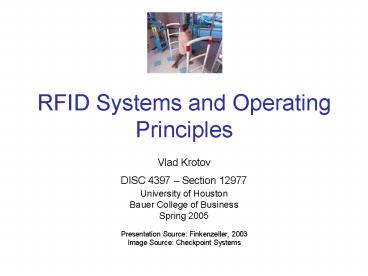RFID Systems and Operating Principles PowerPoint PPT Presentation
1 / 34
Title: RFID Systems and Operating Principles
1
RFID Systems and Operating Principles
- Vlad Krotov
- DISC 4397 Section 12977
- University of Houston
- Bauer College of Business
- Spring 2005
- Presentation Source Finkenzeller, 2003
- Image Source Checkpoint Systems
2
(No Transcript)
3
(No Transcript)
4
Announcements
- Feb 7 class (Monday) will be held
- in room 290G
5
Last class
- 13.56MHz RFID Systems (HF)
- 400-1000MHz RFID Systems (UHF)
- 2.4GHz RFID Systems (Microwave)
6
(No Transcript)
7
Electronic Article Surveillance (EAS)
8
Why EAS?
- Shoplifters steal more than US10 billion a year
from U.S. retailers (60 billion worldwide) - Shoplifting means
- lost sales
- higher inventory costs
- tighter margins
9
Source Checkpoint Systems, 2005
10
Evolution of EAS
- RFID Identification EAS
- Most RFID system (identification) also carry the
functionality for theft prevention - Shrinkage reduction
- POS
- Warehouse
11
1-Bit Transponders
- A bit is the smallest unit of information that
can have only two states - 1 transponder in interrogating zone
- 0 no transponder in interrogating zone
12
EAS system architecture
- Reader antenna
- Security element (tag)
- Deactivation device
- Activator device
13
(No Transcript)
14
Radio Frequency
- The radio frequency (RF) uses LC resonant
circuits adjusted to a particular frequency - Tags Modern Systems employ coils etched between
foils in the form of a stick-on label
15
Radio Frequency
- The reader generates a magnetic field in the
radio frequency range - When tag is moves into the vicinity of the
magnetic alternating field, energy from the
alternating field induces voltage in the tags
coil (Faradays Law) - If the frequency of the readers field
corresponds with the frequency of the tags
circuit, the tags circuit produces a sympathetic
oscillation (also starts to oscillate)
16
Radio Frequency
- The current that that flows in the tags circuit,
as a result of the sympathetic oscillation,
ultimately acts against its cause the magnetic
field of the reader - This resistance leads to a small voltage drop
in the readers coil and ultimately leads to
decrease in magnetic field strength - To ensure better detection rate, the reader may
sweep across frequencies
17
(No Transcript)
18
(No Transcript)
19
Radio Frequency
- In order to deactivate an item, the item is
placed into deactivator - Deactivator generates a sufficiently high
magnetic field that the induced voltage destroys
the foil capacitor of the circuit - The breakdown of the capacitor is irreversible
20
Radio Frequency
- The detection rate can be as low as 70
- The detection rate is heavily influenced by
certain materials (especially metal) - Both reader antenna and tag must have adequate
size to ensure adequate data transmission
21
(No Transcript)
22
Microwave
- Tag received frequency wave from the reader
- Then the tag multiplies the frequency and sends
it back to the reader - After receiving the multiplied frequency
signal, the system is able to detect the presence
of the tag
23
(No Transcript)
24
Microwave
- If the signal is modulated (ASK, FSK), then
interference from other signals can be prevented - Microwave EAS systems are less sensitive to metal
parts - Microwave systems are typically used to protect
textiles
25
(No Transcript)
26
Frequency Divider
- The procedure operates in the long wave range at
100-125.5 kHz - Tag contains a microchip and a resonant circuit
coil made of wound copper - The resonant circuit is made to resonate at the
operating frequency of the EAS system - Tag derives power from the magnetic field
- The frequency received from the reader is divided
by two by the microchip and send back to the
reader - The tag has to be removed from a product after
purchase
27
Electromagnetic EAS
- This type of EAS operates using strong magnetic
fields in the range from 10 Hz to around 20kHz - Tag contains a strip of a soft magnetic metal
- Through magnetization, the strip emits osculation
at the frequency of the system - The tags are usually in the form of self-adhesive
magnetic strips with lengths ranging from 2cm to
20cm - To deactivate a tag, the cashier runs a strong
permanent magnet along the metal strip ?
magnetization of the element - Due to the extremely low frequency,
electromagnetic systems are the only systems
suitable for products containing metal - However, system performance depends on tag
position
28
(No Transcript)
29
Acoustomagnetics
- Tags come in the form of small, thin plastic
boxes - The box contains two metal strips
- Hard metal strip
- Strip made from amorphous metal (can vibrate)
- The strip vibrates at the frequency of the system
- One advantage of this system is the strip
continues to oscillate even after the readers
field is switched off ? higher sensitivity of the
system - To deactivate the tag, it has to be demagnetized
30
(No Transcript)
31
Transmission Procedures
- In the half duplex procedure (HDX) the data
transfer from the transponder to the reader
alternates with data transfer from the reader to
the transponder - In the full duplex procedure (FDX) the data
transfer from the transponder to the reader takes
place at the same time as the data transfer from
the reader to the transponder - In the sequential systems (SEQ), the transfer of
energy from the reader takes place for a limited
period of time. Data transfers occur in between
these energy pulses
32
Advantages of SEQ Systems
- The available operating voltage is up to twice
that of a comparable half/full duplex systems - The energy available to the chip can take,
theoretically any value
33
Data Transmission
- AKS amplitude shift keying
- FSK frequency shift keying
- PSK phase shift keying
- Most systems use ASK
34
(No Transcript)

